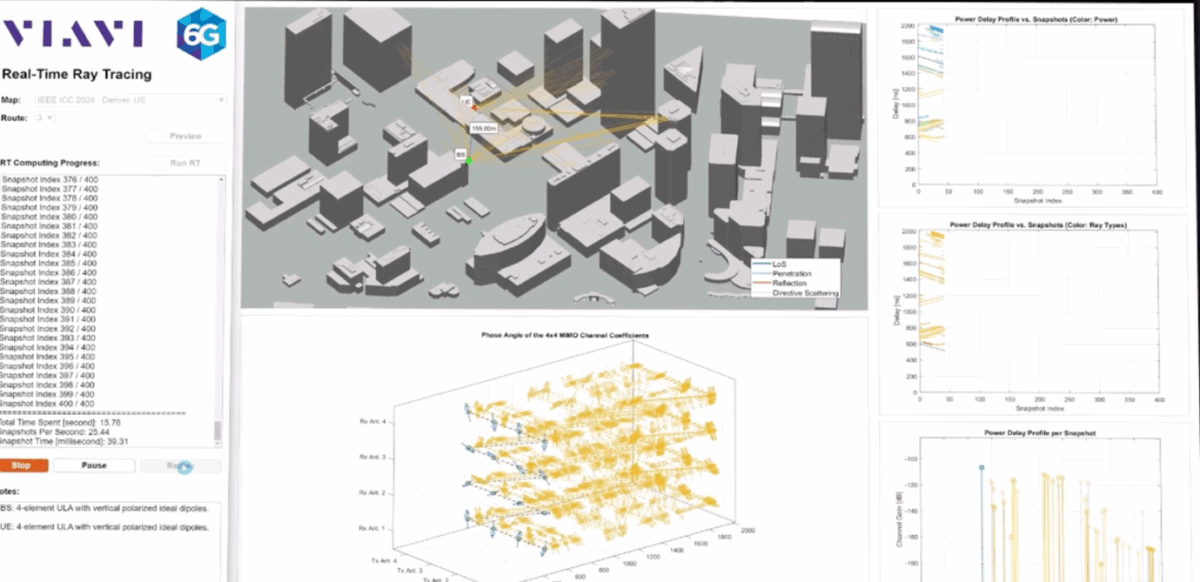Accelerating 6G and NTN Development and Rollouts through Network Digital Twins

Digital twins — virtual models of physical systems like 6G, NTN, and 5G — make it possible to simulate, analyze, and optimize all network systems and components, including their non-terrestrial elements. This is especially useful for accelerating rollouts and identifying bottlenecks and drawbacks before they become real problems.
In this blog series, we will examine how implementing digital twins can benefit network equipment manufacturers and mobile operators and explore its role in R&D acceleration, site deployment automation, spectrum and energy optimization. We will provide use cases, proposed system details, and examples of how VIAVI is implementing and delivering such technology with its partners.
Read the second blog here.
Benefits of digital twins for network equipment vendors
When it comes to the development and rollout of network equipment, digital twins offer two major benefits – especially given the growing complexity brought by Open RAN and Non-Terrestrial Networks, AI and large data, and low latency demands.
First and foremost, digital twins play a pivotal role in performance validation, particularly in complex, multi-vendor environments like Open RAN where interoperability challenges surpass those of traditional network architectures. They offer a virtual environment to simulate and evaluate end-to-end network behavior against key performance indicators (KPIs), enabling comprehensive analysis across both RAN and core domains. This includes testing critical factors such as scalability, reliability, and traffic flow, as well as assessing the impact of introducing new radio, distributed, or central units (RU, DU, CU). By identifying performance bottlenecks, predicting failure points, and validating workflows and recovery mechanisms in a risk-free setting, digital twins significantly reduce deployment uncertainties. Most importantly, they provide a clear picture of the potential risks (or confirm the absence of them) when integrating new hardware or software components. This fosters operator confidence and accelerates adoption of Open RAN architectures.
Secondly, digital twins are critical to model cyber-attack scenarios and patterns on equipment, helping to identify vulnerabilities and ensure accurate firewall testing and other prevention measures. This involves developing and executing numerous dynamic security test cases across the wireless ecosystem to ensure network components are compliant and do not affect network performance. VIAVI digital twin tools, such as TeraVM Security, demonstrate how a specific component fares under the weight of a cyberattack.
Environment Modeling
VIAVI brings deep expertise in creating realistic lab environments that mirror real-world network conditions. This enables accurate and repeatable testing scenarios for next-generation mobile networks.
Traffic Modeling
The TM500 wireless network tester emulates thousands of mobile devices, providing a highly realistic UE digital twin. It has been validated by nearly all network equipment manufacturers in the mobile network sector, ensuring reliable and consistent traffic modeling across diverse network conditions.
RAN Modeling
To simulate system-level RAN behaviors, VIAVI has developed the TeraVM AI RSG (RAN Scenario Generator), which can emulate a wide range of topologies, configurations, mobility patterns and traffic profiles, on both real and synthetic maps. This allows for the generation of large volumes of realistic traffic for the testing and training of AI engines and applications.
Channel Modeling
VIAVI’s AI-powered Ray Tracing tool enables channel prediction for 3D environments and supports planning for indoor and outdoor scenarios, along with coverage and interference optimization, including for massive MIMO.

Collectively, these tools generate vast amounts of data and play a critical role in testing how network equipment performs and how it will behave in a real-world network. The integration of automation tools further streamlines these campaigns.
Another good example of these systems in action can be seen at Northeastern University’s Institute for Wireless Internet of Things and the Open6G collaborative research center. Developed in partnership with VIAVI as part of its 6G Forward Program, the institute has created a city-scale digital twin that implements AI and machine learning technologies that are instrumental in training the AI-native air interface for 6G.
Beyond advancing the industry’s understanding of network dynamics and performance, these initiatives underscore the importance of AI and machine learning in radio propagation modeling for large-scale network digital twins.
Digital twin use case examples for network equipment manufacturers
In this section, we’ve outlined two 6G scenarios where digital twins empower network equipment manufacturers to go beyond 5G networks to prove 6G radio capability and to verify sensing algorithm performance for 6G ISAC when integrated into networks.
For each scenario, we’ve listed and linked the tools involved, with further details listed in a white paper on digital twins.
Proving 6G radio capability
During the early stages of 6G radio development, demonstrating the benefits of FR3 radio over previous generations can be challenging.
With the limited availability of 6G radios and user equipment (UE), it becomes difficult to showcase performance across scenarios involving multiple moving UEs, interactions with 5G radios, and responses to anomalies.
To address this, ray tracing plays a key role by enabling detailed modeling and analysis of RF propagation across various environments. It allows for the simulation of how wireless signals interact with specific environmental features.
From these simulations, detailed maps of FR1 and FR3 behavior can be generated, with the ability to inject anomalies and model complex scenarios involving thousands of variables.
As we’ve mentioned, such a digital twin would implement a UE emulator (TM500 Network Tester), an AI RSG and a ray tracing component (VIAVI Air Interface Emulation). In addition to this, VIAVI’s VAMOS, which is an AI-driven automation platform that enables the automation and orchestration of test campaigns and their execution in a cloud-based Lab-as-a-Service platform.
6G ISAC Validation
In 6G networks (both sub-6 GHz and mmWave), Integrated Sensing and Communications (ISAC) provide capabilities such as high-accuracy localization, gesture recognition, and environmental mapping, while simultaneously enhancing communication services.
To integrate ISAC into 6G base stations and radios, engineers are using unified hardware platforms that combine communication and sensing functions. These platforms support shared spectrum usage and the development of dual-functional waveforms that serve both purposes.
AI is also incorporated to enable their dynamic adaptation based on radio-side measurements. Of course, validating these ISAC algorithms is essential to ensure they work as expected in real-world conditions.
This is where digital twins come in. They support both mono-static and bi-static use cases by integrating a UE emulator for communication testing (TM500), a ray tracing component to simulate channels with dynamic targets like drones, vehicles, pedestrians, and buildings (VIAVI Air Interface Emulation), a sensing receiver emulator, and a map-based channel emulator for realistic environmental modeling.
Evolving digital twin solutions
VIAVI offers a flexible, scalable solution for digital twins that supports everything from individual components to complete RAN-to-core digital twins.
With decades of experience across lab, field, and operational environments and a leading R&D team, VIAVI is here to help you demonstrate the accuracy and value of your network equipment.
For more information on our digital twin solutions, a white paper is downloadable in pdf format.




